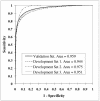Detecting asthma exacerbations in a pediatric emergency department using a Bayesian network
- PMID: 17238428
- PMCID: PMC1839558
Detecting asthma exacerbations in a pediatric emergency department using a Bayesian network
Abstract
Objective: To develop and evaluate a Bayesian network to identify patients eligible for an asthma-care guideline using only data available electronically at the time of patient triage.
Population: Consecutive patients 2-18 years old who presented to a pediatric emergency department during a 2-month period.
Methods: A network was developed and evaluated using clinical data from patient visits. An independent reference standard for asthma guideline eligibility was established and verified for each patient through chart review. Outcome measures were area under the receiver operating characteristic curve, sensitivity, specificity, predictive values, and likelihood ratios.
Results: We enrolled 3,023 patient visits, including 385 who were eligible for guideline-based care. Area under the receiver operating curve for the network was 0.959 (95% CI = 0.933 - 0.977). At a fixed 90% sensitivity, specificity was 88.3%, positive predictive value was 44.7% and negative predictive value was 98.8%. The positive likelihood ratio was 7.69 and the negative likelihood ratio was 0.11.
Conclusion: The Bayesian network was able to detect patients eligible for an asthma guideline with high accuracy suggesting that this technique could be used to automatically initiate guideline use for eligible patients.
Figures
Similar articles
-
Prospective evaluation of a Bayesian Network for detecting asthma exacerbations in a Pediatric Emergency Department.AMIA Annu Symp Proc. 2006;2006:1085. AMIA Annu Symp Proc. 2006. PMID: 17238704 Free PMC article.
-
Comparing decision support methodologies for identifying asthma exacerbations.Stud Health Technol Inform. 2007;129(Pt 2):880-4. Stud Health Technol Inform. 2007. PMID: 17911842
-
Automatic identification of patients eligible for a pneumonia guideline.Proc AMIA Symp. 2000:12-6. Proc AMIA Symp. 2000. PMID: 11079835 Free PMC article.
-
A readers' guide to the interpretation of diagnostic test properties: clinical example of sepsis.Intensive Care Med. 2003 Jul;29(7):1043-51. doi: 10.1007/s00134-003-1761-8. Epub 2003 May 7. Intensive Care Med. 2003. PMID: 12734652 Review.
-
Assessing test accuracy and its clinical consequences: a primer for receiver operating characteristic curve analysis.Ann Clin Biochem. 1993 Nov;30 ( Pt 6):521-39. doi: 10.1177/000456329303000601. Ann Clin Biochem. 1993. PMID: 8304720 Review. No abstract available.
Cited by
-
Prediction of chronic obstructive pulmonary disease (COPD) in asthma patients using electronic medical records.J Am Med Inform Assoc. 2009 May-Jun;16(3):371-9. doi: 10.1197/jamia.M2846. Epub 2009 Mar 4. J Am Med Inform Assoc. 2009. PMID: 19261943 Free PMC article.
-
Asthma Exacerbation Prediction and Risk Factor Analysis Based on a Time-Sensitive, Attentive Neural Network: Retrospective Cohort Study.J Med Internet Res. 2020 Jul 31;22(7):e16981. doi: 10.2196/16981. J Med Internet Res. 2020. PMID: 32735224 Free PMC article.
-
The RAD score: a simple acute asthma severity score compares favorably to more complex scores.Ann Allergy Asthma Immunol. 2011 Jul;107(1):22-8. doi: 10.1016/j.anai.2011.03.011. Epub 2011 Apr 22. Ann Allergy Asthma Immunol. 2011. PMID: 21704881 Free PMC article.
-
Comparing predictions made by a prediction model, clinical score, and physicians: pediatric asthma exacerbations in the emergency department.Appl Clin Inform. 2013 Aug 7;4(3):376-91. doi: 10.4338/ACI-2013-04-RA-0029. eCollection 2013. Appl Clin Inform. 2013. PMID: 24155790 Free PMC article.
-
Development of an asthma management system in a pediatric emergency department.AMIA Annu Symp Proc. 2009 Nov 14;2009:142-6. AMIA Annu Symp Proc. 2009. PMID: 20351838 Free PMC article.
References
-
- American lung association epidemiology and statistics unit. database on the Internet. New York, NY: The American Lung Association; [cited 2/1/2006]. Available from: http://www.lungusa.org.
-
- National Heart, Lung, and Blood Institute, National Asthma Education and Prevention Program. 1997. Expert Panel Report 2: Guidelines for the diagnosis and management of asthma. NIH publication number.97–4051.
-
- Scribano PV, Lerer T, Kennedy D, Cloutier MM. Provider adherence to a clinical practice guideline for acute asthma in a pediatric emergency department. Acad Emerg Med. 2001;8(12):1147–1152. - PubMed
-
- McDermott MF, Grant EN, Turner-Roan K, Li T, Weiss KB. Asthma care practices in Chicago-area emergency departments. Chicago Asthma Surveillance Initiative Project Team. Chest. 1999;116(4 Suppl 1):167S–173S. - PubMed
-
- Grimshaw JM, Eccles MP, Walker AE, Thomas RE. Changing physicians' behavior: what works and thoughts on getting more things to work. J Contin Educ Health Prof. 2002;22(4):237–243. - PubMed


